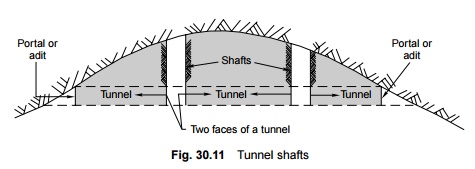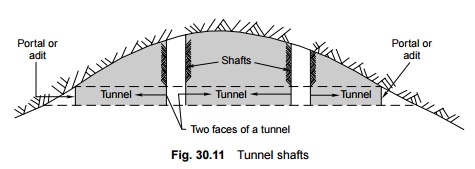Chapter: Civil : Railway Airport Harbour Engineering : Railway Engineering : Railway Tunnelling
Railway Tunnelling: Lighting, Drainage, Shaft of Tunnels

Lighting of Tunnels
It is very important to ensure
that the tunnels are well lit so that the various activities and operations
involved in tunnelling can be carried out effectively and safely. The common
types of lighting equipment normally used in tunnels are electric lights, coal
gas or acetylene gas lights, or lanterns. Electric lights are considered the
best option, as these radiate bright light of the required intensity, are free
from smoke, are easily manoeuvrable from the point of view of extension, etc.
Places where plenty of light
should normally be provided are operation points, equipment stations, bottom of
shafts, storage points, tempering stations, underground repair shops, etc.
Drainage of Tunnels
Good drainage of the tunnels is
very essential in order for them to operate safely and smoothly during the
construction period as well as afterwards. The sources of water for this
purpose include ground water and water collected from the washing of bore
holes. Water seeping in up through the ground as well as from the washing of
bore holes is collected in sump wells and pumped out. If the tunnel is long, a
number of sump wells are provided for the collection of water.
After the construction is over,
drainage ditches are provided along the length of the portion of the tunnel
that slop from the portal towards the sump well and are used for pumping the
water out.
Shaft of Tunnels
Shafts (Fig. 30.11) are vertical
wells or passages constructed along the alignment of a tunnel at one or more
points between the two entrances. A shaft is provided for the reasons listed
below.

Working shafts These are
provided for the expeditious construction of tunnels by tackling the
same at a number of points. These are generally vertical and of a minimum size
of 3.7 m × 3.7 m or of a diameter of 4.30 m.
Ventilation purposes In order
to ensure better ventilation, these shafts are generally inclined and
have a girder size of about 1.2 m diameter.
Related Topics